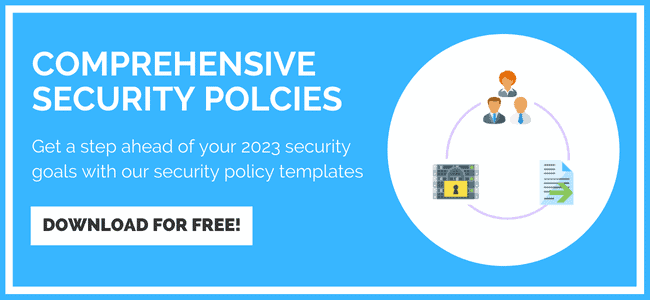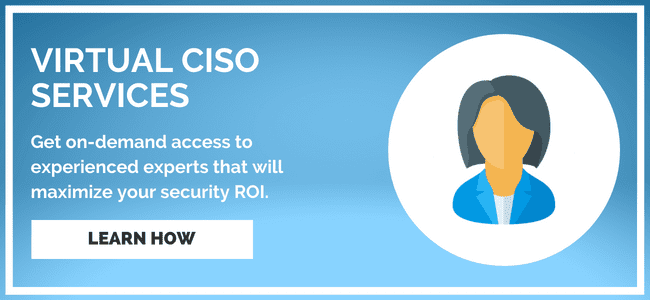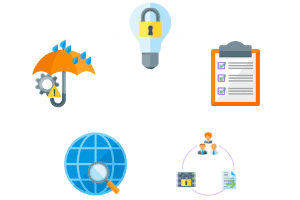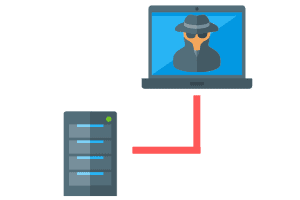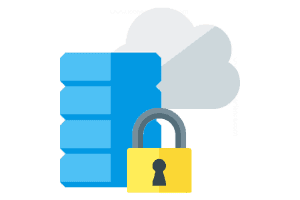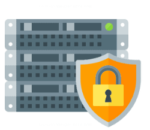Previous
What Does A Virtual CISO Do?
(Roles & Responsibilities Explained)
Learn how PurpleSec’s Virtual CISO services can help you build your security program.
Author: Michael Swanagan, CISSP, CISA, CISM / Last Updated: 3/27/2023
Reviewed By: Rich Selvidge, CISSP
View Our: Editorial Process
Table Of Contents
The role of a virtual CISO is to be the ultimate security advisor for businesses, providing specialized advice regarding policy implementation and compliance guidelines. They can offer valuable insight into managing risks and threats, as well as developing best practices that will protect against any potential data breaches or cyber attacks.
What You’ll Learn
- vCISO roles and responsibilities in security operations and compliance.
- Discover benefits like cost savings, flexibility, and security awareness.
- Understand vCISO key skills: technical, business, communication, and leadership.
- Learn about top challenges in 2023, such as limited resources and third-party risks.
- The value of a vCISO for small and medium-sized businesses’ cyber security.
A virtual CISO can provide leadership in key areas of your cyber security program at a reduced cost, compared to a full-time CISO.
Despite its benefits, many organizations have passed on this service.
A recent study reported 64% of SMB’s do not have a CISO.
If your organization is within this percentage, this article can help address your concerns.
In this article, we will explore the roles and responsibilities of the vCISO, and help you decide if this service is a fit for your company.
Let’s learn the basics of the vCISO service in our first section.
The Basics Of A Virtual CISO
In order to determine if the vCISO service is a fit for your business, a clear understanding of the role is important.
This service will work alongside your infrastructure teams and stakeholders related to compliance and cyber security.
The purpose of the vCISO is to manage and lead projects related to your security strategy, not to perform the role of a security analyst or engineer.
Let’s note the key benefits of hiring a virtual CISO including:
- Cost savings – Lower in cost compared to hiring a full-time CISO.
- On demand service – Can be utilized for short-term initiatives with long-term benefits.
- Service flexibility – Allows you to select a subject matter expert for a specific compliance or cyber security project requirement.
- Staff augmentation – Can fill the role of a CISO temporarily.
- Leadership – Provides direction on implementing components of your security strategy.
- Security Awareness – Provides training, and increases the priority of security within the organization.
Learn More: How To Hire A Virtual CISO
Let’s now take a look at the key responsibilities of the vCISO service in the next section.
Virtual CISO’s Key Responsibilities
The vCISO service is a multi-faceted role that allows you to select a service for a specific need.
You can determine the quality of the Managed Security Provider by the range of expertise their vCISO team members bring to the table.
Let’s explore a few of the services the vCISO is expected to provide in this section.
Security Operations
Leads and manages the security operations function of your organization.
Note the key areas of responsibility the vCISO below:
- Lead vulnerability risk assessments.
- Lead implementation of cyber security frameworks, i.e., NIST 800-53, ISO 27002.
- Provide oversight on incident response planning.
- Create and maintain security policies and procedures.
- Serve as an advisor for Governance, Risk, and Compliance.
- Provide leadership in performing regulatory assessments.
- Coordinate Disaster Recovery processes, and procedures.
Disaster Recovery
Develop and implement your Disaster Recovery and Business Continuity Plan policy.
Note the following areas of responsibility related to disaster recovery:
- Identify and prioritize key assets for the plan.
- Schedule and plan periodic exercises of the plan.
- Manage disaster recovery exercises and provide feedback to stakeholders.
- Document the Disaster Recovery and Business Continuity Plans.
- Provide a strategic plan for backup of critical assets and systems.
Security Finance Management
Conduct asset management reviews to identify if resources are clearly identified and secured.
Note additional areas where the vCISO service can provide leadership:
- Quantifies the overall value of security initiatives based on asset discovery and prioritization.
- Assess the cost of all security tools or systems, and analyzes the return on investment.
Documentation
Establishes a detailed documentation standard and review process.
Documentation covers a wide range of systems.
Note the following areas where the vCISO is responsible for:
- Contributes to the development and documentation of key cyber security related policies, such as, HR management, GRC (Governance, Risk, and Compliance), Change Control, and Incident Response Management.
- Maintains a standard approval process for policy reviews, i.e., annual or semi-annual reviews.
Compliance
Provides leadership and guidance on the implementation of regulatory compliance objectives.
The vCISO is expected to be current on the impact of regulatory compliance updates related to the organization they are supporting.
Note a sample of regulations in the list below:
Program Onboarding
Promotes the process of SDLC in new internal systems and a standard for onboarding approval.
- Ensures third-party systems meet security standards and align with business strategic objectives
- Maintain a risk assessment standard for new systems, such as penetration testing, or vulnerability scans.
HR Management
Provides leadership in promoting the security awareness program during the onboarding stage of employment for new employees and continuous awareness throughout the year.
- Ensures Human Resources onboarding policy outlines security responsibilities for new employees, contractors, and third-party vendors.
- Establishes a standard for security awareness training and campaigns for all employees
- Develops and maintains the security awareness training program and acknowledgment process.
Now that we’ve reviewed the key responsibilities of the vCISO, let’s now review the expected skillset of the vCISO in our next section.
Virtual CISO’s Skill Set
The skill set of a vCISO is comprised of four main areas of expertise:
- Technical
- Business
- Communication
- Leadership
Let’s examine each in detail in the following section.
Technical Skills
The vCISO should have a deep understanding of cyber security and security technologies used to manage and provide leadership.
The list below are basic skills the vCISO should possess, but not limited to the following:
- Vulnerability Management – Have knowledge of current threats, exploits, and remediation process.
- Data Loss Prevention Technology – Understand the concepts of data at rest, data in motion, data in use.
- Application Web Development – Understand the SDLC concept of application security.
- Network Management – Fundamental knowledge of next generation firewalls and network terminology.
- Mobile Device Management – Have knowledge of mobile and wireless technology standards.
- Incident Management – Key requirement for managing the recovery effort from a data breach or ransomware attack.
- Disaster Recovery & Business Continuity – Required in order to develop plans for testing and recovering from a disaster.
- Risk Management – Required to assess the state of the program and the security technologies required to reduce risk.
- Cloud Technology – Required since most companies are moving from on premise to cloud providers – Google, Azure, or AWS.
In addition, one or more of the following certifications are typically required for the vCISO role.
Business Skills
The vCISO is not solely a technical service, it requires some level of business acumen.
The vCISO should be able to understand business objectives and strategic plans, which relate to the budget.
This is a critical area that demands good communication with non-technical stakeholders and executive leadership.
Communication Skills
Similar to business skills, the vCISO should be able to effectively communicate security risks as it pertains to the business to technical and non-technical staff.
This communication can be conveyed in multiple ways, such as, live video presentations, remote conference calls, documentation, or email.
This level of communication builds relationships and trust with key stakeholders.
Leadership Skills
The foundation of a good leader is good communication skills.
In times of crisis or change, the vCISO may be called upon to inspire and motivate the team to support a new critical initiative.
The vCISO with this quality will garner support from stakeholders and drive more services for the provider.
In our final section, let’s look at the top challenges for the vCISO in 2023.
Virtual CISO’s Top Challenges in 2023
When an organization decides to hire a vCISO, it is typically to solve a problem or enhance an area that may be lacking in support.
This may introduce a set of obstacles the vCISO should expect to navigate through on their assignment.
In this section, we will review the top challenges the vCISO is expected to face in 2023.
Limited Resources
Due to resource constraints, an organization may have limited budgets which in turn impacts the headcount of skilled employees or security tools.
The vCISO will have to adjust and prioritize resources in this situation.
Frequent communication with stakeholders is required to keep them abreast and seek their guidance on resource allocation.
Resistance To Changes
A vCISO is hired to implement a security initiative or improve a current process.
This may incur pushback from team members or employees who are resistant to change.
This could lead to frustration and an extension of the vCISO’s schedule; however, this mindset can be shifted with effective communication.
Once the risk of not implementing a solution is clearly communicated to executive leadership and relevant stakeholders, leadership can assist in driving the initiative forward.
Balancing Security & Business Objectives
With expanded attack surfaces and non-stop threats from various sources, the challenge of balancing security with business objectives is introduced. T
he vCISO will have to work within the risk appetite of the organization as it relates to a new security initiative or processes that may impact the end user experience.
The vCISO will help prepare the organization to remain productive and resilient without compromising security principles.
Managing Third-Party Security Risks
Almost every organization outsources areas of its services or use software maintained by a third party to conduct business over the internet.
Partnering with third parties introduces potential risks that can be detrimental to an organization if exploited.
A vCISO may be hired to develop a strategy around 3rd party risk and remediation planning.
This strategy may include an intensive review of all products and systems that interact with a third-party system, which may be challenging for a part-time vCISO.
The vCISO with experience in this area will build a workflow that improves visibility and remediation activities into the third-party vendor relationships.
Wrapping Up
In this article, we have reviewed the scope of the vCISO’s roles and responsibilities.
With the increase in targeted cyber attacks against SMB’s, an organization has to decide if it is a prudent decision not to consider hiring a vCISO.
We examined the key benefits of hiring a vCISO and the multiple services you can choose from to fit the needs of your organization.
The flexibility of the service and the lower cost compared to a full time CISO can provide short term cost with long term benefits to your organization.
If you are a Small and Medium-Sized Business, hiring a vCISO is an excellent and smart choice that can help improve your cyber security strategy.
By understanding the roles and responsibilities of the vCISO mentioned in this article, your organization is well informed to decide if this service is a good fit for your organization.
Learn more about PurpleSec’s virtual CISO services or schedule a free consultation.

Michael Swanagan, CISSP, CISA, CISM
Michael is an IT security expert with 15 years of proven experience. He has experience leading and supporting security projects and initiatives in the healthcare, finance, and advertising industry.
Recent Articles
Categories
Policy Templates
Popular Articles

